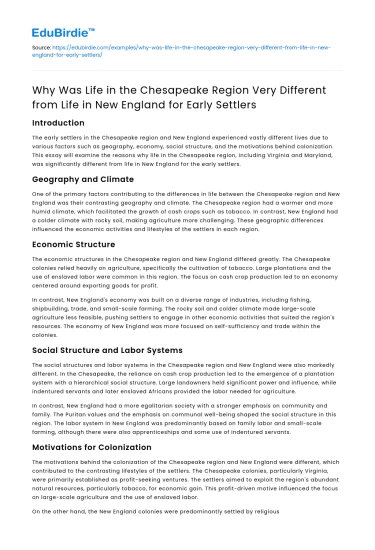Introduction
The early settlers in the Chesapeake region and New England experienced vastly different lives due to various factors such as geography, economy, social structure, and the motivations behind colonization. This essay will examine the reasons why life in the Chesapeake region, including Virginia and Maryland, was significantly different from life in New England for the early settlers.
Geography and Climate
One of the primary factors contributing to the differences in life between the Chesapeake region and New England was their contrasting geography and climate. The Chesapeake region had a warmer and more humid climate, which facilitated the growth of cash crops such as tobacco. In contrast, New England had a colder climate with rocky soil, making agriculture more challenging. These geographic differences influenced the economic activities and lifestyles of the settlers in each region.
Save your time!
We can take care of your essay
- Proper editing and formatting
- Free revision, title page, and bibliography
- Flexible prices and money-back guarantee
Economic Structure
The economic structures in the Chesapeake region and New England differed greatly. The Chesapeake colonies relied heavily on agriculture, specifically the cultivation of tobacco. Large plantations and the use of enslaved labor were common in this region. The focus on cash crop production led to an economy centered around exporting goods for profit.
In contrast, New England's economy was built on a diverse range of industries, including fishing, shipbuilding, trade, and small-scale farming. The rocky soil and colder climate made large-scale agriculture less feasible, pushing settlers to engage in other economic activities that suited the region's resources. The economy of New England was more focused on self-sufficiency and trade within the colonies.
Social Structure and Labor Systems
The social structures and labor systems in the Chesapeake region and New England were also markedly different. In the Chesapeake, the reliance on cash crop production led to the emergence of a plantation system with a hierarchical social structure. Large landowners held significant power and influence, while indentured servants and later enslaved Africans provided the labor needed for agriculture.
In contrast, New England had a more egalitarian society with a stronger emphasis on community and family. The Puritan values and the emphasis on communal well-being shaped the social structure in this region. The labor system in New England was predominantly based on family labor and small-scale farming, although there were also apprenticeships and some use of indentured servants.
Motivations for Colonization
The motivations behind the colonization of the Chesapeake region and New England were different, which contributed to the contrasting lifestyles of the settlers. The Chesapeake colonies, particularly Virginia, were primarily established as profit-seeking ventures. The settlers aimed to exploit the region's abundant natural resources, particularly tobacco, for economic gain. This profit-driven motive influenced the focus on large-scale agriculture and the use of enslaved labor.
On the other hand, the New England colonies were predominantly settled by religious groups seeking religious freedom and the ability to establish their own communities based on their Puritan beliefs. The emphasis on religious values and communal living shaped the social, economic, and political aspects of life in New England.
Conclusion
Life in the Chesapeake region and New England for early settlers differed significantly due to various factors such as geography, economy, social structure, and the motivations behind colonization. The Chesapeake region's reliance on cash crop agriculture, the plantation system, and the use of enslaved labor contrasted with New England's diversified economy, emphasis on communal well-being, and more egalitarian social structure. Understanding these differences helps us appreciate the unique historical developments and legacies of each region, and how they continue to shape American society today.






 Stuck on your essay?
Stuck on your essay?

